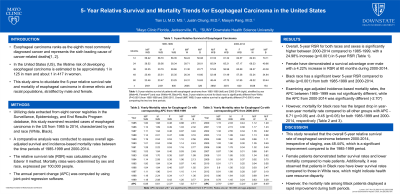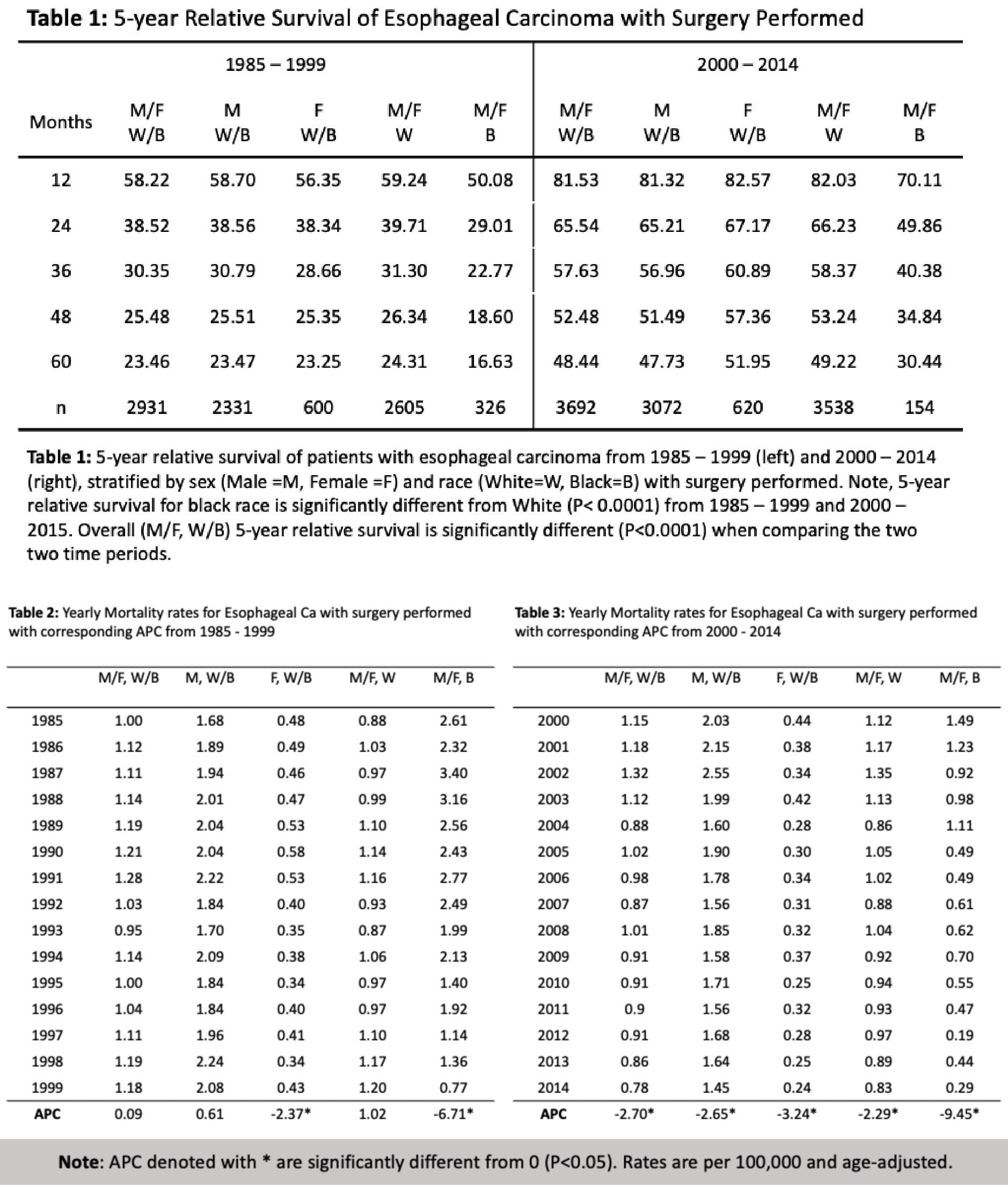Monday Poster Session
Category: Esophagus
P1831 - 5-Year Relative Survival and Mortality Trends for Esophageal Carcinoma in the United States
Monday, October 23, 2023
10:30 AM - 4:15 PM PT
Location: Exhibit Hall

Has Audio

Tian Li, MD, MS
Mayo Clinic Florida
Jacksonville, FL
Presenting Author(s)
Tian Li, MD, MS1, Justin Chung, MD2, Maoyin Pang, MD, PhD1
1Mayo Clinic Florida, Jacksonville, FL; 2SUNY Downstate Health Sciences University, Brooklyn, NY
Introduction: Esophageal carcinoma ranks as the eleventh most prevalent form of cancer globally and represents the sixth leading cause of cancer-related deaths. In the United States (US), the lifetime risk of developing esophageal is estimated to be approximately 1 in 125 in men and about 1 in 417 in women. This study aims to elucidate the 5-year relative survival rate and mortality of esophageal carcinoma in diverse ethnic and racial populations, stratified by male and female.
Methods: Utilizing data extracted from eight cancer registries in the Surveillance, Epidemiology, and End Results Program database, this study examined recorded cases of esophageal carcinoma in the US from 1985 to 2014, characterized by sex and race (White, Black). A comparative analysis was conducted to assess overall age-adjusted survival and incidence -based mortality rates between the time periods of 1985-1999 and 2000-2014. The relative survival rate (RSR) was calculated using the Ederer II method. Mortality rates were determined by sex and race, expressed per 100, 000 people. The annual percent change (APC) was computed by using joint- point regression software.
Results: Overall 5-year RSR for both races and sexes is significantly higher between 2000-2014 compared to 1985-1999, with a 24.98% increase (p< 0.001) in 5- year RSR(Table 1). Female have demonstrated a survival advantage over male with a 4.22 % increase in RSR at 60 months during 2000-2014. Black race has a significant lower 5-year RSR compared to white (p< 0.001) from both 1985- 1999 and 2000-2014.
When examining age-adjusted incidence-based mortality rates, the APC between 1985-1999 was not significantly changed compared to – 2.70 (p< 0.05) between 2000-2014. However, mortality for black race has the largest drop in year-over-year mortality rate compared to all other groups with APC -6.71 (p< 0.05) and – 9.45 (p< 0.05) for both 1985-1999 and 2000-2014, respectively (Table 2 and 3).
Discussion: This study revealed that the overall 5-year relative survival rate of esophageal carcinoma between 2000-2014, irrespective of staging, was 48.44% , which is a significant improvement compared to the 1985-1999 period. Female patients demonstrated better survival rates and lower mortality compared to male patients. Additionally, it was observed that patients in Black race have lower survival rates compared to those in White race. However, the mortality rate among Black patients displayed a rapid improvement during both periods.

Disclosures:
Tian Li, MD, MS1, Justin Chung, MD2, Maoyin Pang, MD, PhD1. P1831 - 5-Year Relative Survival and Mortality Trends for Esophageal Carcinoma in the United States, ACG 2023 Annual Scientific Meeting Abstracts. Vancouver, BC, Canada: American College of Gastroenterology.
1Mayo Clinic Florida, Jacksonville, FL; 2SUNY Downstate Health Sciences University, Brooklyn, NY
Introduction: Esophageal carcinoma ranks as the eleventh most prevalent form of cancer globally and represents the sixth leading cause of cancer-related deaths. In the United States (US), the lifetime risk of developing esophageal is estimated to be approximately 1 in 125 in men and about 1 in 417 in women. This study aims to elucidate the 5-year relative survival rate and mortality of esophageal carcinoma in diverse ethnic and racial populations, stratified by male and female.
Methods: Utilizing data extracted from eight cancer registries in the Surveillance, Epidemiology, and End Results Program database, this study examined recorded cases of esophageal carcinoma in the US from 1985 to 2014, characterized by sex and race (White, Black). A comparative analysis was conducted to assess overall age-adjusted survival and incidence -based mortality rates between the time periods of 1985-1999 and 2000-2014. The relative survival rate (RSR) was calculated using the Ederer II method. Mortality rates were determined by sex and race, expressed per 100, 000 people. The annual percent change (APC) was computed by using joint- point regression software.
Results: Overall 5-year RSR for both races and sexes is significantly higher between 2000-2014 compared to 1985-1999, with a 24.98% increase (p< 0.001) in 5- year RSR(Table 1). Female have demonstrated a survival advantage over male with a 4.22 % increase in RSR at 60 months during 2000-2014. Black race has a significant lower 5-year RSR compared to white (p< 0.001) from both 1985- 1999 and 2000-2014.
When examining age-adjusted incidence-based mortality rates, the APC between 1985-1999 was not significantly changed compared to – 2.70 (p< 0.05) between 2000-2014. However, mortality for black race has the largest drop in year-over-year mortality rate compared to all other groups with APC -6.71 (p< 0.05) and – 9.45 (p< 0.05) for both 1985-1999 and 2000-2014, respectively (Table 2 and 3).
Discussion: This study revealed that the overall 5-year relative survival rate of esophageal carcinoma between 2000-2014, irrespective of staging, was 48.44% , which is a significant improvement compared to the 1985-1999 period. Female patients demonstrated better survival rates and lower mortality compared to male patients. Additionally, it was observed that patients in Black race have lower survival rates compared to those in White race. However, the mortality rate among Black patients displayed a rapid improvement during both periods.

Figure: Table 1: 5-year Relative Survival of Esophageal Carcinoma with Surgery Performed. Table 2: Yearly Mortality Rates for Esophageal Carcinoma with Surgery Performed with Corresponding APC from 1985-1999. Table 3: Yearly Mortality Rates for Esophageal Carcinoma with Surgery Performed with Corresponding APC from 2000-2014
Disclosures:
Tian Li indicated no relevant financial relationships.
Justin Chung indicated no relevant financial relationships.
Maoyin Pang indicated no relevant financial relationships.
Tian Li, MD, MS1, Justin Chung, MD2, Maoyin Pang, MD, PhD1. P1831 - 5-Year Relative Survival and Mortality Trends for Esophageal Carcinoma in the United States, ACG 2023 Annual Scientific Meeting Abstracts. Vancouver, BC, Canada: American College of Gastroenterology.
